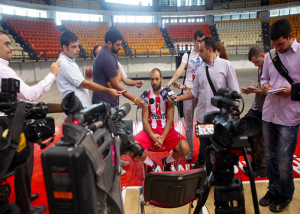 Sports coverage is booming. News about sport used to be confined to a couple of pages at the back of the newspaper, but today it occupies vast areas of print, online and broadcast attention.
Sports coverage is booming. News about sport used to be confined to a couple of pages at the back of the newspaper, but today it occupies vast areas of print, online and broadcast attention.
Sportsmen and women are better known and better paid than ever and the world is hungry for news about them. Sports journalism has long played an important role in attracting and retaining audiences but, according to one observer, it has recently become ‘the heart of the battle for newspaper circulation.’
If sports reporting is booming, what sports are being covered and who is doing the reporting? In both cases it seems that there is a significant gender issue, which is particularly acute in the United Kingdom.
During the London Olympics there was a noticeable increase in the coverage of female sports, but that dissipated in the months that followed. Outside the period of major sporting festivals the evidence from the Women’s Sports and Fitness Foundation is that only 5% of total sports coverage relates to activities by women. Indeed women’s sport is such a paltry Cinderella area that it attracted only a tiny 1% of the total sponsorship and as is well known the salaries and facilities for women’s sport are miniscule by comparison to mens’.
But what is less well known is the position of women as reporters about sport.
Sports journalism has traditionally been seen as a male domain, and research conducted in Australia, for example, suggest that this tradition has not changed. Most sports reporters in the UK are male, and despite increasing numbers of women entering sports journalism since the women’s movement of the 1970s, the number of women sports writers remains very low.
In recent years there has been some considerable progress regarding the visibility of women in broadcast sports journalism. Again the London Olympics was a watershed for UK broadcasting, but there are still relatively few women sports writers in the newspaper industry, and sports journalism is still a largely male-dominated area in countries all over the world.
To find out who was writing about sport we conducted a number of byline surveys in the UK press. We compared six newspapers across two separate weeks in autumn 2012. In another survey we looked at the gender of bylines on sports articles in a different selection of seven newspapers. Once again it was a mixture of tabloid and ‘broadsheet’ publications. Here the aim was to compare a period six months before the London Olympics (February 2012) with six months after (February 2013). A third comparison was made with 2002, a decade before the Olympics in London. In total between both of these surveys almost 10,000 articles were looked at and the gender of the byline was noted.
We had expected the outcome to show that sports journalism is dominated by men, but the results were quite extraordinary. At no point in any of the periods we examined was the proportion of female bylines higher than 3%. There were occasions where the female contribution on one newspaper (Guardian and Daily Mail) for one week reached just over 4%, but the averages were well below this. Over all the periods we studied the average proportion of stories written by women was a mere 1.8%.
The article I published together with Deirdre O’Neill in Journalism, Theory, Practice and Criticism gives a detailed breakdown and analysis of all the data.
Two other factors struck us as especially surprising. The impact of the London Olympics on female sports writing was negligible, despite the relatively high profile of women in sport and sports broadcasting over that period. The figures for female bylines in 2013 were barely changed from the previous year. And indeed they were barely different from 2002.
A further observation is the extent to which the UK figures compare internationally. In 2011 a wide ranging German survey of sports writing across 22 countries examined 80 newspapers and a total of 11,000 separate articles. It found that the overall proportion of articles by female journalists was 8%. So although the results were not great, they were rather better than the UK figures.
The paucity of women writing about sport continues to be of wide concern. Surveys in the US reinforce our findings, showing the same lack of female sports editors and reporters. The US studies also indicate that there is still some prejudice faced by those women who do become sports journalists.
The first female sports editor of a UK national newspaper was appointed in 2013 when Alison Kervin took up the post at the Mail on Sunday. But that is only a small improvement and sports journalism has a long way to go before it can demonstrate a more balanced and equal workforce.
This article is based on Women Reporting Sport: Still a Man’s Game? Franks, S. & O’Neill, D
Tags: Journalism, Journalism research, journalists, media, Research, Sports Journalism












































